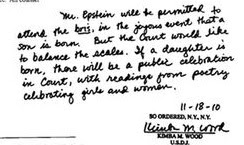In my second year of rabbinical school at the Jewish Theological Seminary, I took a year-long seminar that focused on Jewish life-cycle observances. Of course, we covered all the basics like the bris, the Jewish wedding and the Jewish funeral. But we spent more time discussing life-cycle events that traditionally had been given short shrift. In fact, we devoted a great deal of time discussing appropriate ceremonies for the birth of a Jewish baby girl.
For generations, the birth of a baby boy in Judaism was cause for great celebration. The bris, or ritual circumcision, meant a crowded home event with festive foods, speeches, singing, and celebration. Relatives and friends would travel great distances to attend the bris on the eighth day of the baby’s life, carrying gifts with them for the elated parents. The birth of a baby girl often meant nothing more than a synagogue honor for the newborn’s father while mother and baby were still in the hospital. In recent time, it has been a naming ceremony after baby girl’s first month, or any time in the first year when the parents got around to it.
Beginning with recommended rituals for welcoming a newborn girl into the Jewish faith by the authors of the 1960s classic The First Jewish Catalog: A Do It Yourself Classic and continuing more recently with Debra Nussbaum Cohen’s wonderful Celebrating Your New Jewish Daughter: Creating Jewish Ways to Welcome Baby Girls into the Covenant-New and Traditional Ceremonies, greater attention has been paid to welcoming ceremonies for Jewish baby girls.
On Thanksgiving Day, 2005, my wife and I welcomed our twin son and daughter into the Jewish covenant with separate ceremonies that took place in the synagogue one after the other. We figured that they were born minutes apart, so their naming ceremonies should be minutes apart as well. On the eighth day of their lives, they would become part of the Jewish people in rituals that were different, yet balanced. Our son had the traditional bris and then our daughter had a “Simchat Bat,” in which she was blessed by her female relatives in a candlelighting ceremony. Rather than wait a month or longer to bestow a Hebrew name on our daughter, we chose to make both our son and daughter the main event of this life-cycle event attended by many friends and family.
I am feeling nostalgic as the fifth anniversary of that special event, in which neither male nor female was favored above the other, approaches. And so, I had to smile when I read about Judge Kimba Wood’s recent decision in a case in which a lawyer asked to be excused from court if and when his pregnant daughter’s baby turns out to be a boy. Kimba Wood was one of the judges nominated by President Bill Clinton to be Attorney General of the United States before Janet Reno was eventually confirmed. Both she and fellow nominee Zoe Baird were brought down by stories involving their nannies. Wood is also known as the judge who sentenced the “Junk Bond King” Michael Milken to ten years in prison.
Apparently, like me, Kimba Wood recognizes the unfairness in making a big fuss over a Jewish boy’s birth, but seeing a Jewish girl’s birth as a lesser event. Here is the letter to Judge Kimba Wood by attorney Bennett M. Epstein, with Wood’s response following:
Dear Judge Wood:
I represent Mark Barnett in the above matter, which is scheduled for trial beginning November 29th.
Please consider this letter as an application in limine for a brief recess in the middle of trial on the grounds known (perhaps not now, but hereafter) as a “writ of possible simcha]”.
The facts are as follows: My beautiful daughter, Eva, married and with a doctorate no less, and her husband, Ira Greenberg ( we like him, too) live in Philadelphia and are expecting their first child on December 3rd, tfu tfu tfu. They do not know whether it will be a boy or a girl, although from the oval shape of Eva’s tummy, many of the friends and family are betting male (which I think is a mere bubbameiseh but secretly hope is true).
Should the child be a girl, not much will happen in the way of public celebration. Some may even be disappointed, but will do their best to conceal this by saying, “as long as it’s a healthy baby”. My wife will run to Philly immediately, but I will probably be able [to] wait until the next weekend. There will be happiness, though muted, and this application will be mooted as well.
However, should baby be a boy, then hoo hah! Hordes of friends and family will arrive from around the globe and descend on Philadelphia for the joyous celebration mandated by the halacha to take place during the daylight hours on the eighth day, known as the bris. The eighth day after December 3rd could be right in the middle of the trial. My presence at the bris is not strictly commanded, although my absence will never be forgotten by those that matter.
So please consider this an application for maybe, tfu tfu tfu, a day off during the trial, if the foregoing occurs on a weekday. I will let the Court (and the rest of the world) know as soon as I do, and promise to bring pictures.
Very truly yours,
Bennett M. Epstein
Judge Kimba Wood’s response:









